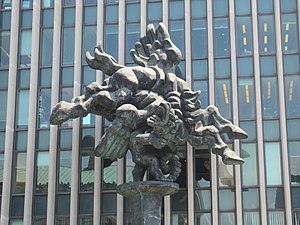| Bellerophon Taming Pegasus | |
|---|---|
 The sculpture in 2014 | |
 | |
| Artist | Jacques Lipchitz |
| Year | 1977 |
| Type | Sculpture |
| Subject | Bellerophon taming Pegasus |
| Location | New York City |
| 40°48′25.4″N 73°57′38″W / 40.807056°N 73.96056°W | |
Bellerophon Taming Pegasus is an outdoor sculpture by Jacques Lipchitz, depicting Bellerophon and Pegasus. It was the final sculpture worked on by Lipchitz, and was completed after his death in 1973.
The work depicts the human figure of Bellerophon, standing on a high plinth, tying a rope around the neck of the thrashing Pegasus, whose tail, legs and wings splay dramatically around the central figures. It has been interpreted as a representing man taming nature. In the words of the artist, "You observe nature, make conclusions, and from these you make rules… and law is born from that".[1] It takes inspiration from Lipchitz's earlier work, Birth of the Muses, which depicts Pegasus landing on Mount Olympus.[2]
The sculpture was commissioned by architect Max Abramovitz for Columbia Law School in 1964.[3] It was cast in bronze at Pietrasanta in Italy, shipped in pieces to be constructed in New York City, and dedicated on November 28, 1977.[1] It is installed above the west entrance of Jerome Greene Hall on Revson Plaza, on the Columbia University campus in Manhattan. Nearby on the plaza are casts of Henry Moore's Three-Way Piece: Points, Tightrope Walker by Kees Verkade, Life Force by David Bakalar, and Flight by Gertrude Schweitzer.[1]
The 23 ton sculpture measures approximately 30 feet (9.1 m) by 28 feet (8.5 m), and stands on a 27-foot (8.2 m) high pedestal, making it, after the Statue of Liberty, the second-largest metal statue in New York City, as of 2022.[1][4]
The Tate Gallery in London holds a plaster "sketch" from 1964, presented by the Lipchitz Foundation in 1982.[5] Another 1964 plaster "sketch" is held by the Museo Reina Sofía in Madrid.[6]
A 12-foot bronze cast - about half the size of the original - is at the Broadgate development in London.[7] Another cast was installed in Kansas City in 2000.[8]
-
Bellerophon Taming Pegasus, Broadgate Estate, London
-
Birth of the Muses, MIT Campus, Cambridge, Massachusetts
- ^ a b c d "Flying Horses, Tightrope Walkers and Other Campus Icons". Columbia Law School. 7 August 2007. Archived from the original on 5 July 2016. Retrieved 19 June 2014.
- ^ Birth of the Muses Archived 12 October 2015 at the Wayback Machine, Jacques Lipchitz, MIT List Visual Arts Center
- ^ Lipchitz, Jacques; Arnason, H.H. (1972). My Life in Sculpture. The Viking Press, Inc. p. 214.
- ^ Moffitt-Hawasly, Kelly; Pellerito, Jennifer (15 August 2022). "A Walking Tour of Sculptures On and Around Columbia's Morningside Campus". Columbia News. Archived from the original on 11 August 2023. Retrieved 19 August 2022.
- ^ Lipchitz, Sketch for Bellerophon Taming Pegasus 1964 Archived 24 September 2015 at the Wayback Machine, Tate
- ^ Sketch for Bellerophon taming Pegasus Archived 9 December 2021 at the Wayback Machine, Museo Nacional Centro de Arte Reina Sofía
- ^ Bellerophon Taming Pegasus Archived 6 December 2016 at the Wayback Machine, Broadgate
- ^ Bellerophon Taming Pegasus, 1965, Museum Without Walls

